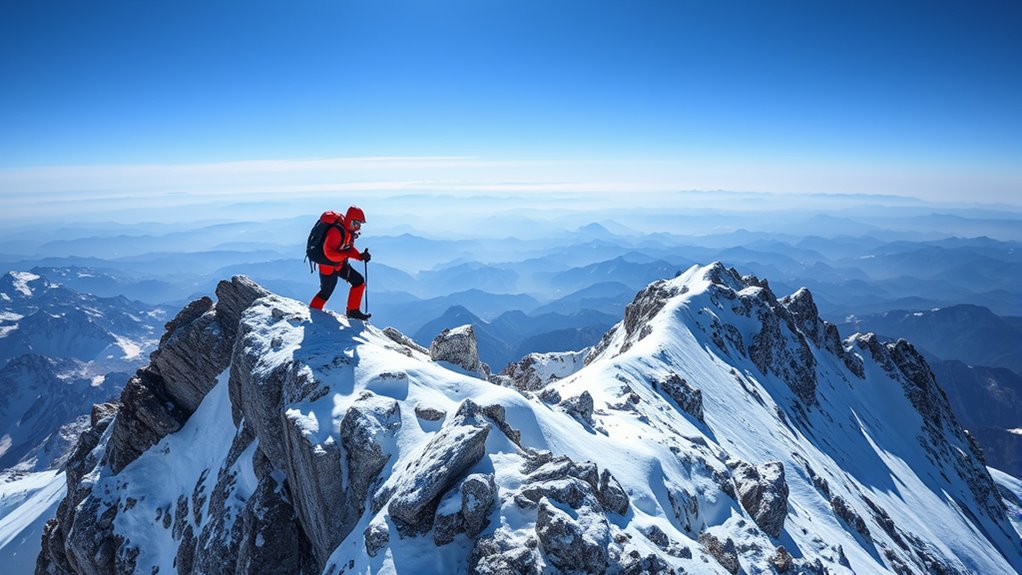Whether you need altitude training depends on your athletic goals and ability to adapt. It can boost endurance by increasing red blood cells and improving oxygen use, but it requires proper acclimatization to avoid health risks. Rushing the process can hinder progress or cause altitude sickness. If you’re willing to plan carefully and give your body time to adjust, altitude training could be beneficial. Keep exploring to learn how to do it safely.
Key Takeaways
- Altitude training enhances endurance and oxygen efficiency, benefiting athletes and endurance enthusiasts.
- Proper acclimatization is essential; rushing can cause altitude sickness and impair performance.
- Not everyone needs altitude training; it’s most useful for high-altitude athletes or those preparing for competitions at altitude.
- Alternatives like simulated altitude tents can provide benefits without the health risks of high-altitude exposure.
- Consulting a healthcare professional ensures safe and effective altitude training tailored to individual needs.

Have you ever wondered why athletes train at high elevations? The answer lies in the concept of mountain acclimatization and the effects of hypoxia. When you ascend to higher altitudes, the air becomes thinner, meaning there’s less oxygen available. This reduced oxygen, or hypoxia, pushes your body to adapt quickly. During mountain acclimatization, your body responds by producing more red blood cells to carry oxygen more efficiently. This process can enhance your endurance once you return to lower elevations, making you feel stronger and more resilient during competitions or intense workouts.
Training at high elevations boosts endurance by increasing red blood cells through mountain acclimatization.
However, acclimatization isn’t automatic or effortless. It requires time—often weeks—to fully adapt. Initially, you might experience symptoms like shortness of breath, fatigue, headaches, or dizziness. These are normal hypoxia effects that signal your body is working to adjust. If you don’t give yourself enough time to acclimate, your performance can suffer, and you might even risk altitude sickness, which can be dangerous. That’s why many athletes plan their altitude training carefully, gradually exposing themselves to higher elevations to allow their bodies to adapt without undue stress.
Understanding mountain acclimatization is vital if you’re considering altitude training. It’s not just about climbing higher; it’s about giving your body the right environment to optimize oxygen uptake and red blood cell production. This process enhances your aerobic capacity, allowing you to perform better in competitions at sea level or lower elevations. But it’s important to listen to your body during this period. Symptoms of altitude sickness or severe hypoxia effects aren’t signs to ignore—they’re signals that you need to descend or rest.
Altitude training isn’t a magic bullet for improving performance. It requires patience, proper planning, and awareness of your body’s responses to hypoxia. Some athletes incorporate altitude tents or simulated environments if they can’t access mountain ranges, but the underlying principle remains the same: your body needs time and proper conditions to adapt. Without adequate mountain acclimatization, you might not reap the full benefits, or worse, you could jeopardize your health.
In essence, understanding the effects of hypoxia and the importance of mountain acclimatization helps you decide whether altitude training is right for you. It’s not just about reaching a certain elevation; it’s about giving your body the chance to adjust safely and effectively. When done correctly, altitude training can boost your endurance and performance, but rushing the process or neglecting your body’s signals can do more harm than good.
Frequently Asked Questions
Can Altitude Training Improve My Overall Athletic Performance?
Yes, altitude training can improve your overall athletic performance by enhancing hypoxia adaptation and providing cardiovascular benefits. When you train at high altitudes, your body adjusts to lower oxygen levels, increasing red blood cell production and oxygen delivery. These adaptations boost your endurance and recovery, helping you perform better in competitions. Just guarantee you follow a proper training plan to maximize benefits and minimize potential risks.
How Long Should I Stay at High Altitude for Benefits?
Sure, you should stay at high altitude for about 2-3 weeks, but don’t forget, altitude acclimation isn’t just about time—it’s about quality sleep. Ironically, the more you push yourself, the more sleep quality might decline, affecting your gains. To truly benefit, limit your stay to avoid fatigue, while prioritizing rest. That way, you maximize altitude benefits without sacrificing recovery.
Are There Any Health Risks Associated With Altitude Training?
Yes, altitude training can pose health risks like oxygen deprivation and altitude sickness. You might experience headaches, nausea, or fatigue as your body adapts to lower oxygen levels. To minimize risks, stay hydrated, ascend gradually, and listen to your body’s signals. If symptoms worsen, descend immediately. Always consult with a healthcare professional before starting altitude training to ensure it’s safe for you.
Is Altitude Training Effective for All Sports?
Altitude training isn’t effective for all sports because it relies on altitude adaptation, which enhances endurance and oxygen efficiency. However, performance variability occurs depending on the sport and individual response. If you’re in endurance sports like running or cycling, it can boost your stamina. But for power or skill-based sports, the benefits are limited. Consider your goals and sport-specific needs before integrating altitude training into your regimen.
What Are the Best Methods to Simulate High Altitude Conditions?
You can simulate high altitude conditions effectively using hypoxic tents or altitude masks. Hypoxic tents create a controlled low-oxygen environment, mimicking altitude training indoors, while altitude masks restrict airflow during workouts. Both methods boost your red blood cell production and oxygen efficiency. You should choose based on convenience and comfort; hypoxic tents are more consistent, but altitude masks are portable and easy to use anywhere.
Conclusion
If you’re considering altitude training, think about your goals and current fitness level. For example, a marathon runner trained at high altitude might see improved endurance, but only if they adapt properly. Remember, it’s not a one-size-fits-all solution. Consulting with a coach or medical professional can help you decide if altitude training’s right for you. Sometimes, simple adjustments to your training routine can bring big gains without the altitude.









